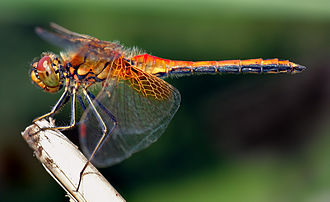 February 23, 2015 (Monday)
February 23, 2015 (Monday)
Today I will conduct funeral services for Myrtle Shedd, a member of Bethel Baptist Church, Ingleside, where I am currently serving as interim pastor. Please pray for her husband, Clifford, as he grieves this loss after 56 years of marriage. After services at the church, interment will take place at Palms Memorial Gardens cemetery, located between Portland and Taft.
It will be cold, rainy and windy at the graveside, according to the weather forecast. I have conducted 15 burial services in that very beautiful cemetery through the years, and remember how cold it can get there, surrounded by cleared crop land without a windbreak in sight.
One of the visits to that cemetery, however, was unique, but not because of the weather. It was different because on that day thousands of dragonflies (we called them “mosquito hawks” when I was a child) were there. Their presence was welcomed by us visitors because they were gobbling up mosquitoes. We were seeing God’s pest control at work.
One of the scenes from my childhood that I recall vividly pictures me sitting on the ground at the edge of a ditch in front of our house In the Lindale neighborhood of Houston, and watching the dragonflies feasting over the waters of the ditch. I loved how they hovered as if they were sizing up their prey and picking out a choice delicacy for their next big bite.
 Part of their scientific classification name means “uneven,” referring to their two sets of wings. The ones in front are not as broad as the others. Dragonflies are among the fastest flying insects in the world. Dragonflies can fly backwards, change direction in mid-air and hover for up to a minute. They have six legs but can’t walk very well, which is OK because they do their work in flight.
Part of their scientific classification name means “uneven,” referring to their two sets of wings. The ones in front are not as broad as the others. Dragonflies are among the fastest flying insects in the world. Dragonflies can fly backwards, change direction in mid-air and hover for up to a minute. They have six legs but can’t walk very well, which is OK because they do their work in flight.
About 5,900 different species of dragonflies are known in the world today. Dragonflies eat mosquitoes, and they also eat flies, bees, ants, wasps, and every once in a while a butterfly. As happens in the natural world, the eater is eaten as they become food for birds, lizards, frogs, spiders, fish, water bugs, and even other large dragonflies. That’s just the way it all works. (We humans think we are at the top of a food chain, but every so often a bear or tiger explodes that theory). The greatest danger to their existence, however, is human. The destruction of their habitat causes their extinction in some places. Vehicular traffic on roads near wetlands result in unbelievable numbers of deaths from collision between vehicle and insect. What a shame, because they are here as great contributors to the balance of nature and, as always, when we hurt the natural world, we hurt ourselves in the long run.
I don’t know why I remember the “mosquito hawks” of my childhood so vividly, but I get a little nostalgic every time I think about them, watching them fly up, down, side to side, backward and forward, sometimes at 60 mph, or just sitting there in mid-air, as if they were saying, “Hi, kid, how’s your day going?”
